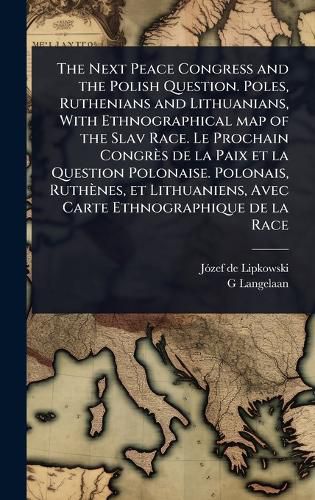Readings Newsletter
Become a Readings Member to make your shopping experience even easier.
Sign in or sign up for free!
You’re not far away from qualifying for FREE standard shipping within Australia
You’ve qualified for FREE standard shipping within Australia
The cart is loading…






This title is printed to order. This book may have been self-published. If so, we cannot guarantee the quality of the content. In the main most books will have gone through the editing process however some may not. We therefore suggest that you be aware of this before ordering this book. If in doubt check either the author or publisher’s details as we are unable to accept any returns unless they are faulty. Please contact us if you have any questions.
a??The Next Peace Congress and the Polish Questiona?? examines the complex geopolitical landscape of Eastern Europe, focusing on the Polish question and its intersection with Ruthenian and Lithuanian populations. This work by JA3zef de Lipkowski and G. Langelaan delves into the historical and ethnic dynamics of the region, providing insights into the challenges of establishing lasting peace. Including an ethnographical map of the Slav race, the book offers a valuable perspective on the intricate relationships between various ethnic groups and their political aspirations. It serves as a crucial resource for understanding the historical context of Eastern European conflicts and the enduring quest for stability in the region. This historical analysis remains relevant for scholars and readers interested in political science, ethnic studies, and European history.
This work has been selected by scholars as being culturally important, and is part of the knowledge base of civilization as we know it. This work was reproduced from the original artifact, and remains as true to the original work as possible. Therefore, you will see the original copyright references, library stamps (as most of these works have been housed in our most important libraries around the world), and other notations in the work.
This work is in the public domain in the United States of America, and possibly other nations. Within the United States, you may freely copy and distribute this work, as no entity (individual or corporate) has a copyright on the body of the work.
As a reproduction of a historical artifact, this work may contain missing or blurred pages, poor pictures, errant marks, etc. Scholars believe, and we concur, that this work is important enough to be preserved, reproduced, and made generally available to the public. We appreciate your support of the preservation process, and thank you for being an important part of keeping this knowledge alive and relevant.
$9.00 standard shipping within Australia
FREE standard shipping within Australia for orders over $100.00
Express & International shipping calculated at checkout
Stock availability can be subject to change without notice. We recommend calling the shop or contacting our online team to check availability of low stock items. Please see our Shopping Online page for more details.
This title is printed to order. This book may have been self-published. If so, we cannot guarantee the quality of the content. In the main most books will have gone through the editing process however some may not. We therefore suggest that you be aware of this before ordering this book. If in doubt check either the author or publisher’s details as we are unable to accept any returns unless they are faulty. Please contact us if you have any questions.
a??The Next Peace Congress and the Polish Questiona?? examines the complex geopolitical landscape of Eastern Europe, focusing on the Polish question and its intersection with Ruthenian and Lithuanian populations. This work by JA3zef de Lipkowski and G. Langelaan delves into the historical and ethnic dynamics of the region, providing insights into the challenges of establishing lasting peace. Including an ethnographical map of the Slav race, the book offers a valuable perspective on the intricate relationships between various ethnic groups and their political aspirations. It serves as a crucial resource for understanding the historical context of Eastern European conflicts and the enduring quest for stability in the region. This historical analysis remains relevant for scholars and readers interested in political science, ethnic studies, and European history.
This work has been selected by scholars as being culturally important, and is part of the knowledge base of civilization as we know it. This work was reproduced from the original artifact, and remains as true to the original work as possible. Therefore, you will see the original copyright references, library stamps (as most of these works have been housed in our most important libraries around the world), and other notations in the work.
This work is in the public domain in the United States of America, and possibly other nations. Within the United States, you may freely copy and distribute this work, as no entity (individual or corporate) has a copyright on the body of the work.
As a reproduction of a historical artifact, this work may contain missing or blurred pages, poor pictures, errant marks, etc. Scholars believe, and we concur, that this work is important enough to be preserved, reproduced, and made generally available to the public. We appreciate your support of the preservation process, and thank you for being an important part of keeping this knowledge alive and relevant.